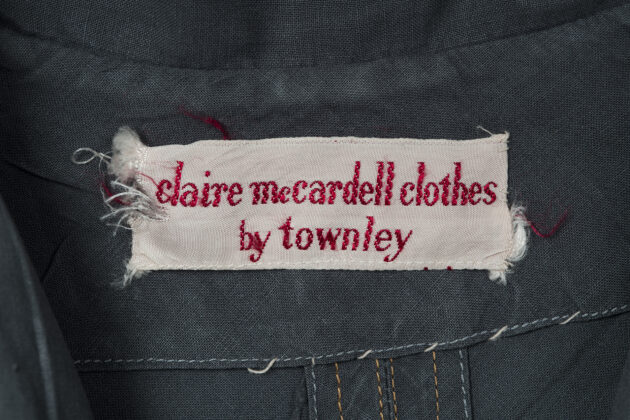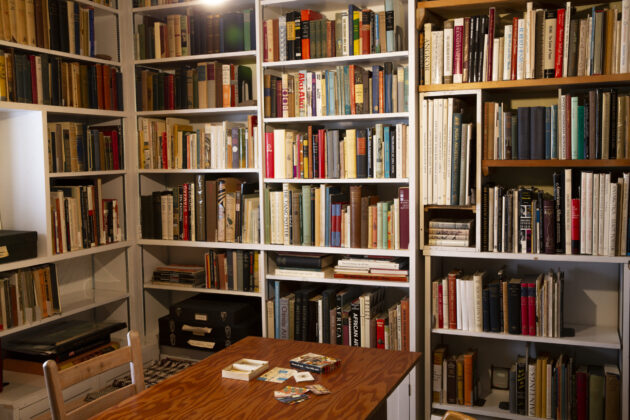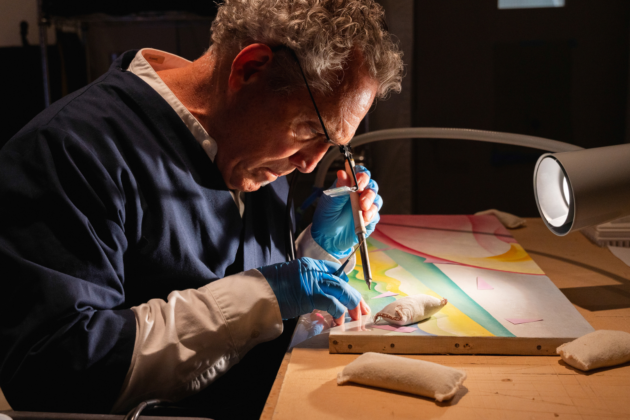
Examining New Dimensions through the Retrospective
On July 6th the Tate Modern premiered a major retrospective of the career of Georgia O’Keeffe, the gallery’s first major exhibition since its reopening this year. The show will encompass some of the earliest moments of O’Keeffe’s creative development, beginning with abstractions from the time of her 1916 debut, before progressing chronologically through later segments of her career when the landscapes of New Mexico and overseas destinations served as the primary sources of her inspiration.
In my excitement for the opening of this exhibition, which was accomplished thanks to many months of hard work from the staff here at the Georgia O’Keeffe Museum, I found myself researching some of the major exhibitions of O’Keeffe’s work that have occurred in the past. As it turns out, several of these events bear some interesting similarities to, and also differences from, Georgia O’Keeffe at the Tate.
The Tate’s retrospective marks a number of milestones. It is the first exhibition to premiere at the Tate following the completion of a seven year, £260 million redesign and expansion project that will further establish Tate as one of London’s foremost cultural anchors and one of the major centers for modern art in Europe. Secondly, it is the largest and most comprehensive exhibition of Ms. O’Keeffe’s artworks ever staged in Europe, and because of the small number of her works currently housed in European collections, it is likely to maintain this distinction for some time. Finally, it seems fitting for the 100th anniversary of the artist’s gallery debut, a 1916 exhibition of ten drawings at Alfred Stieglitz’s 291, to be marked by an international tour of over one hundred of her most accomplished oil paintings, watercolors, and drawings.
I found that the Tate retrospective parallels another landmark exhibition of O’Keeffe’s work which occurred in 1946 at the Museum of Modern Art. Composed of a comparatively modest 57 artworks, the MOMA’s 1946 exhibition was the first ever solo retrospective devoted to a female artist at the Museum. Curator and future Guggenheim director James Johnson Sweeny arranged the show in a similar manner to the Tate’s current exhibition, following a forward chronological retrospective model.
One of the most notable parallels between the MOMA’s 1946 retrospective and the Tate’s current exhibition is the urgency among critics, scholars, and the public alike to explore new dimensions of O’Keeffe’s art. Natural abstractions, particularly those of flowers, are the most recognizable works associated with Georgia O’Keeffe. While these are significant paintings, they represent only a narrow portion of the entirety of O’Keeffe’s career as an artist. Even in 1946, when most of these works were less than thirty years old, critics were pining for exposure to new aspects of her vision. Art critic Emily Genauer regretted the presence of only three works from O’Keeffe’s 1915 formative period, in the form of one watercolor and two charcoal drawings. She writes of her admiration for the early works on paper,
They’re the sparest kind of abstraction – so slight as to be little more than a line or two and a spot of color – although they are surprisingly expressive.[i] – Emily Genauer, New York World Telegram
Genauer went on to state the striking qualities that endeared O’Keeffe’s early abstractions to her and other critics become present again in what were the artist’s latest works at the time. She cited works like Black Place No. 1 and Dark Mesa and Pink Sky as possessing the movement, rhythm, and expression that characterized her earliest abstractions and echoing their unique austerity. This sentiment was apparently shared with the New York Times’s Edward Alden Jewell, who wrote, “I am relieved to find that not too much stress is laid on the prolific magnified-flower motif.”[ii] Instead, he extols the bolstering effects of the show’s generous attention to O’Keeffe’s later landscape paintings from New Mexico.
The public and critical communities’ yearning for a more comprehensive experience of O’Keeffe’s work has been considered by Tate curator Tanya Barson, who told Aesthetica that the Tate’s retrospective will embrace the diversity of themes O’Keeffe explored throughout her career while simultaneously emphasizing her clear aesthetic vision. To accomplish this, the exhibition is arranged in a thematic as well as chronological sequence in order to complicate and add greater depth to the typical retrospective model.
Finally, the Tate’s retrospective will cause visitors to reconsider not only the visual and artistic themes associated with Georgia O’Keeffe, but also the historical and social implications of the relationship between her, Alfred Stieglitz, and her art. Unlike Sweeney, who in 1946 headlined the MOMA’s press release for his O’Keeffe retrospective with Stieglitz’s proclamation of adoration for O’Keeffe’s drawings, “Finally a woman on paper,” Barson is questioning the traditional understandings of Stieglitz’s influence on O’Keeffe’s art. As told by Barson and Achim Borchardt-Hume, Tate’s director of exhibitions, Stieglitz originally promoted the often asserted erotic connotations of O’Keeffe’s flower paintings, which she refused to acknowledge. The Tate is providing visitors with an opportunity to reevaluate these assumptions and supposed erotic undertones.
Borchardt-Hume states that a major goal of the exhibition is to allow O’Keeffe’s work to be read on multiple levels from multiple perspectives, a privilege that was reserved mainly for male artists in the first half of the twentieth century and was subsequently crystallized in the collective consciousness of the art world, which was profoundly influenced by male critics and scholars. Sweeney framed Stieglitz’s close relationship to O’Keeffe as essential to her success as an artist, but new understandings of the effects of his influence on the interpretation of her art, as well as re-considerations of the treatment of female artists in art history, have been developed in the seventy years since the MOMA retrospective, and the Tate is striving to engage these new ideas.
When considering the MOMA’s 1946 Georgia O’Keeffe retrospective and the Tate Modern’s current exhibition, it seems as if major showings of O’Keeffe’s work often serve as focal points for historic milestones. The landmark status of the 1946 show stems from its designation as the first retrospective at the MOMA devoted to a female artist. In 2016, this status is due to an obstruction and removal of the male gaze from O’Keeffe’s work in order to clarify new dimensions and meanings and to reconsider established interpretations of the contributions of female artists to art history. While the former event is more groundbreaking in a symbolic sense, the Tate’s retrospective potentially has even deeper and farther-reaching implications. Comparing these two exhibitions demonstrates the potential for the retrospective as a platform for deconstructing outdated narratives and allowing more comprehensive and holistic interpretation of historical and art historical subjects. The Tate has appropriately selected Georgia O’Keeffe as the focus of this exhibition approach, as her body of work possesses the complex and layered diversity essential to realizing the full potential of focusing on alternative aspects of an artist’s career. In this case, this approach will eschew the gendered interpretations of Georgia O’Keeffe’s work in order to forward a more complete understanding of her vision.
Well–I made you take time to look at what I saw and when you took time to really notice my flower you hung all your own associations with flowers on my flower and you write about my flower as if I think and see what you think and see of the flower–and I don’t. -Georgia O’Keeffe, 1936
This post was written by Patrick Gora, Registrar Intern, Georgia O’Keeffe Museum.
Featured image: Georgia O’Keeffe Exhibition: An American Place, Interior Gallery View, Alfred Stieglitz 1931, photographic print, 8 x 10”, Gift of the Georgia O’Keeffe Foundation, Georgia O’Keeffe Museum
[i] Genauer, Emily. “Georgia O’Keeffe’s Exhibit.” New York World Telegram, May 18, 1948.
[ii] Jewell, Edward Alden. “Exhibition Offers Work by O’Keeffe.” The New York Times, May 15, 1946.


